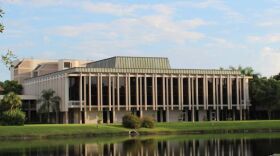Southwest Lee County and Northeast Collier County are both experiencing extreme drought conditions, according to the U.S. Drought Monitor.
Howard Brogdon, the Water Division Director in Collier County, said this isn’t much different than droughts in previous years, but residents should conserve water.
“We look at everything that we do as a shared responsibility. Residents should absolutely do their part,” he said.
Collier County is not under a water shortage, but the drought brings with it a possible impact to local water resources. This could be a water shortage from the groundwater aquifers and fields that use those aquifers.
Brogdon said drought conditions also can impact the availability of water to fight fires.
Collier County issued a burn ban at the beginning of March. Since it’s still the dry season, and despite some recent rains, the ban remains in effect.
The South Florida Water Management District (SFWMD) has water conservation rules, which Collier County has in its ordinances. This includes no irrigating between 10 a.m. and 4 p.m.
“Those measures relate to making sure that we limit the impact of brush fires by ensuring that we have water available and also ensuring that we don't lead to increasing the brush fires by not implementing a burn ban,” Brogdon said.
Collier County pulls 46% of its drinking water from an alternate water supply. This means it comes from brackish, groundwater sources, which doesn’t put as much pressure on the freshwater source.
Brogdon also said that 80% of the water that’s used in Collier County is reused, such as for irrigation. This also helps.
“We put less of a strain on the fresh water supply which makes more of it available to use for means that might be able to address drought conditions,” Brogdon said.
Dr. Donald Duke, a professor and interim chair at FGCU’s Water School, said the drought conditions are reflective of the dry season and not an environmental anomaly.
He said local ecosystems have adapted to the dry seasons. Certain birds like storks prefer to wade and feed in shallow water during the mostly dry winter and spring in Florida.
“A seasonal low water level isn't necessarily damaging,” Dr. Duke said. “When it gets drier than expected, or less water than planned for when we think about human usage, that's a different issue.”
While ecosystems have adapted, humans haven’t. This means cutting back on water usage whenever possible.
Despite this Duke said water usage in South Florida depends entirely on the wet season. While the dry season routinely suppresses water levels, the wet season replenishes needed water, and then some.
According to SFWMD, the wet season, usually from May 15 to Oct. 15, brings about 70% of South Florida’s average amount of rainfall.
Dr. Duke said drought in winter and spring can be typical, but a drought during Florida’s wet season poses a heightened issue.
“If we had a less than normal wet season, then we would have difficulty with water for humans and the environment here,” he said.
While the wet season brings an abundance of water, residents must conserve water each day during the dry season. The fact that rain will come later in the year doesn’t change the fact that water needs to be saved now.
“Cutting back now would make the difference between having enough water available to last until we start to get, you know, robust supplies again,” Duke said.
Right now Lee County officials urge people to conserve water to protect the declining groundwater levels throughout the county.
Current rainfall in Lee County is 1.75 inches behind the seasonal average. Drinking water aquifers are below year-ago levels, according to Lee County. There is short-term stress on the county’s water resources because of that. And hurricane recovery workers and seasonal residents also are here, tapping the water supplies.
“Reducing usage now is vital to protecting the resource, especially for those with home wells,” Lee County said in a news release.
Cape Coral recently issued a release that stated while it’s under a severe drought, the area could soon join Southwest Lee County in extreme drought conditions.
Kaitlyn Mullen, the senior public information specialist for Cape Coral, said the city urges residents to voluntarily conserve irrigation water by watering lawns only once a week.
Every day, Cape Coral pumps 16 million gallons into Gator Slough from Charlotte County to rehydrate the city’s freshwater canals, which are at low levels. About two-thirds of the water that supplies Cape Coral’s irrigation system comes from its 300 miles of freshwater canals, Mullen said.
“Water demands are high,” Mullen said. “Supplies are extremely low due to the persistent drought that Southwest Florida is experiencing.”
SFWMD provides simple steps that South Floridians can take to conserve water.
- Water the lawn just once per week. Most lawns only need ¾ to 1 inch of water each week. Overwatering makes the lawn more vulnerable to drought.
- Fix leaks in toilets, faucets and irrigation systems. One leaky faucet can waste 100 gallons of water in a single day!
- Turn off water while brushing teeth or shaving
- Set washing machines to the minimum water level.
Every day, more than 3 billion gallons of water are used in central and southern Florida by around 9 million residents and millions of visitors.
This story was produced by Democracy Watch, a news service provided by Florida Gulf Coast University journalism students. The reporter can be reached at katiefogarty22@gmail.com.
WGCU is your trusted source for news and information in Southwest Florida. We are a nonprofit public service, and your support is more critical than ever. Keep public media strong and donate now. Thank you.







